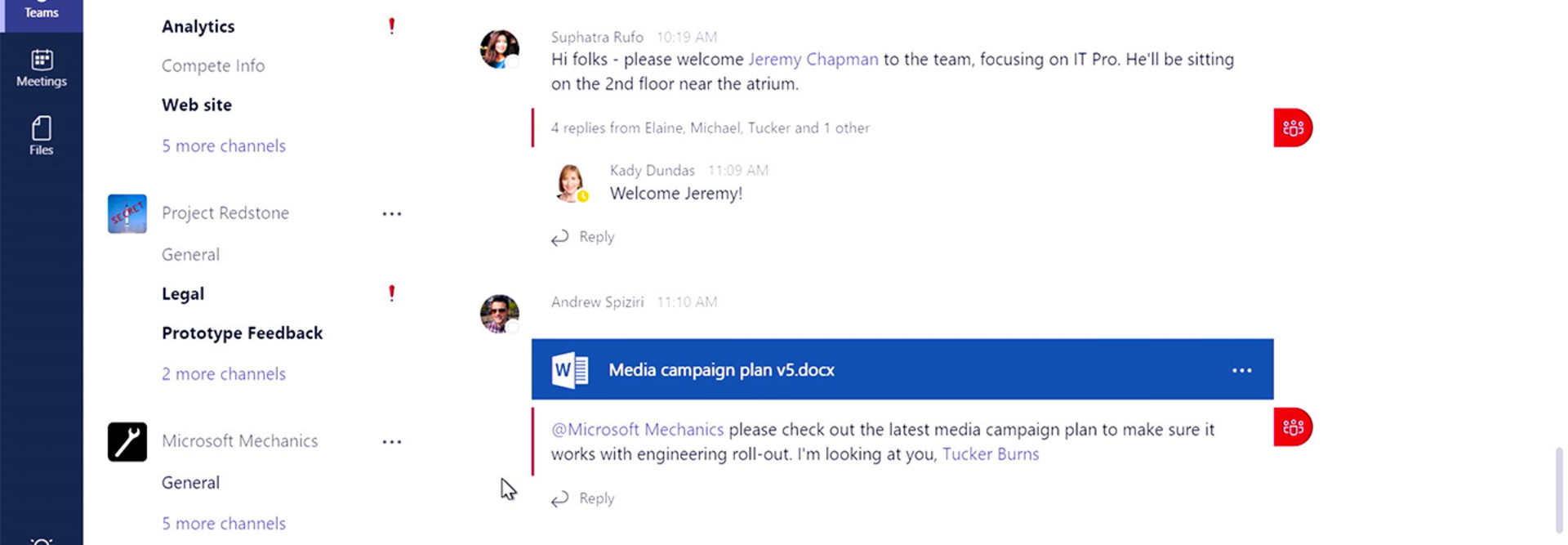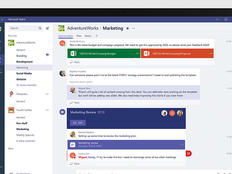Microsoft Teams Debuts for Office 365 Users as Workplace Collaboration Market Expands
Microsoft on Tuesday formally unveiled Teams, its new workplace collaboration tool designed to give users more options for team-based chatting and group work beyond Slack, Google Hangouts, Facebook’s Workplace, Cisco Systems’ Spark and others.
Teams is now available to Microsoft Office 365 business users in 181 markets and 19 languages. With 85 million active users, the Office 365 user base provides Microsoft with a sizable platform to cultivate usage of the new tool.
In a company blog post, Kirk Koenigsbauer, corporate vice president for the Office 365 client apps and services team, noted that since Microsoft announced the preview of Teams in November, more than 50,000 organizations have started using the tool, including Accenture, Alaska Airlines, Cerner, ConocoPhillips, Deloitte, Expedia, J.B. Hunt, J. Walter Thompson, Hendrick Motorsports, Sage, Trek Bicycle and Three UK. Microsoft has introduced more than 100 new features since then, “to deliver ongoing innovation and address top customer requests,” Koenigsbauer says.
A Different Kind of Workplace Collaboration Tool
Teams is similar to Slack and other chat-based collaboration tools in many ways, but Microsoft is hoping that by integrating it with Office 365, business users will take a shine to its interface and features.
The tool provides users with threaded, persistent chat in multiple channels, plus audio calling from mobile devices and video on Android (coming soon to iOS and Windows Phone). Microsoft also added the ability to email a channel, including attachments; send messages with markdown-based formatting; and receive notifications about all posts in a channel. Within the basic framework of a left rail with channels and a wider space for the stream of chats familiar to Slack users, TechCrunch reports that "Microsoft takes you into a pretty huge range of different options that tap into its many other products. These include direct chats, the option to hold audio and video calls, the ability to call in spreadsheets and other documents, run some analytics and more, along with spaces for 'evergreen' content as well as others for more rapidly changing data."
Teams also now supports many accessibility features, including support for screen readers, high contrast and keyboard-only navigation.
Microsoft’s core Office applications — Word, Excel, PowerPoint, OneNote, SharePoint and Power BI — are integrated with Teams. The software giant also recently added support for open, public teams within an organization. Microsoft has also “enhanced the meeting experience by adding scheduling capabilities, integrating free/busy calendar availability for team members, adding recurrence, and making it easier to transition from chat to high-quality voice and video,” according to Koenigsbauer.
Additionally, Teams supports integration with chatbots, and Microsoft is partnering with SAP and Trello on new integrations. “SAP SuccessFactors will help employees and managers track goals and performance as part of the way they work in Microsoft Teams every day,” Koenigsbauer noted. “Trello will empower teams to easily get projects done with boards, lists and cards right within Microsoft Teams.”
Koenigsbauer also highlighted the security features of Teams: “Finally, Microsoft Teams is built on the Office 365 hyper-scale, enterprise-grade cloud, delivering the advanced security and compliance capabilities our customers expect. Microsoft Teams supports global standards, including SOC 1, SOC 2, EU Model Clauses, ISO27001 and HIPAA. We also added support for audit log search, eDiscovery and legal hold for channels, chats and files as well as mobile application management with Microsoft Intune. And starting today, Microsoft Teams is automatically provisioned within Office 365.”
With Teams, Microsoft isn’t aiming to eliminate email, and plans to more deeply integrate Teams and Outlook. “We see Teams as a chat-based workspace,” Brian MacDonald, the corporate vice president who heads up Microsoft Teams, said at a launch event, according to ZDNet. “There are different types of teams and collaboration, and different types of tools for each.”
“Outlook is a hub you live in. Teams is a hub you live in,” MacDonald added. “Unlike Slack, we are not trying to kill email. We're building strong integration between the two.”
A Marketplace in Flux
The Microsoft announcements comes shortly after Google decided to split its Hangouts service into two distinct apps: Hangouts Chat and Hangouts Meet.
The Chat service will serve as a group chat and collaboration tool similar to Teams and Slack. As The Verge reported, like Microsoft, Google is “betting that deep integration with the rest of its office suite is going to be catnip for IT managers and cost-conscious CFOs.”
Meanwhile, Meet is designed to be a lightweight video conferencing service that is easy to access via laptops or mobile devices. According to a survey released earlier this year by online IT community Spiceworks, Skype for Business is the market leader in workplace collaboration, with 36 percent of organizations using it, followed by Google Hangouts at 16 percent and Slack at 13 percent. Both Microsoft Teams and Workplace by Facebook, which the social network unveiled in October, had fairly low adoption (Teams was at 3 percent; Workplace was at 1 percent), but Spiceworks says that’s an expected finding given how new they are in the market.
Spiceworks found that larger organizations are significantly more likely to use Skype for Business than smaller organizations, “perhaps because the large group conferencing and user account management features offered with Skype for Business make more sense as companies grow in size,” Spiceworks IT analyst Peter Tsai wrote in a blog post.
On the other hand, small and medium-sized businesses are slightly more likely to use Google Hangouts and Slack than their larger counterparts, which could speak to the benefits they bring in cost and usability.
Looking forward, Spiceworks expects Skype for Business and Microsoft Teams to see the most growth. Although only 3 percent of organizations use Microsoft Teams today, an additional 17 percent of organizations are expected to adopt it within the next two years. Skype for Business is expected to pick up an additional 11 percent of organizations within the same time frame.
If these plans hold true, Microsoft Teams will be the second most commonly used messaging platform in the workplace by the end of 2018, surpassing Slack and Google Hangouts, and coming in behind only Skype for Business, according to Spiceworks. Since Microsoft also owns Skype, it could move into a dominant position in office collaboration.









